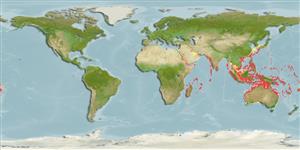Common names from other countries
Issue
Apogonichthyoides enigmaticus is considered valid in Ref. 88147:68.
Environment: milieu / climate zone / depth range / distribution range
Ekologi
laut berasosiasi dengan karang; kisaran kedalaman 3 - 60 m (Ref. 30874), usually 10 - 34 m (Ref. 37816). Tropical
Indo-West Pacific: Red Sea (Ref. 84159), East Africa to the Philippines (Ref. 559), north to Miyakejima, Japan (Ref. 559) and Taiwan (Ref. 9147), south to northern Australia (Ref. 2334) and Society Islands (Ref. 76833).
Size / Weight / umur
Maturity: Lm ? range ? - ? cm
Max length : 10.0 cm TL jantan/; (Ref. 559); common length : 8.0 cm SL jantan/; (Ref. 37816)
Duri punggung (Keseluruhan (total)) : 8; duri punggung lunak (Keseluruhan (total)) : 9; Duri dubur: 2; Sirip dubur lunak: 8. Reddish dorsally, yellowish ventrally. Body depth lower than A. aureus and no wide black band on caudal peduncle (Ref. 559). Juveniles pale with short blue lines on snout (Ref. 48635). Adults to deep golden with blue spots in three rows on mid-lateral surface of body (Ref. 93839).
Inhabits rocky cliffs. Also in sheltered coastal to outer reefs from shallow flats to over 50 m depth. Usually in pairs, small aggregations, or occasionally schooling (Ref. 48635). Occurrence is rather rare (Ref. 559). Feeds on zooplankons and invertebrates (Ref. 89972). Minimum depth reported taken from Ref. 9710.
Mouthbrooders (Ref. 240). Distinct pairing during courtship and spawning (Ref. 205).
Gon, O., 1986. Apogonidae. p. 546-561. In M.M. Smith and P.C. Heemstra (eds.) Smiths' sea fishes. Springer-Verlag, Berlin. (Ref. 4329)
Status IUCN Red List (Ref. 130435)
CITES (Ref. 128078)
Not Evaluated
ancaman kepada manusia
Harmless
penggunaan manusia
Alat, peralatan
laporan khas
muat turun XML
Sumber internet
Estimates based on models
Preferred temperature (Ref.
115969): 24.5 - 29.1, mean 27.5 (based on 694 cells).
Phylogenetic diversity index (Ref.
82804): PD
50 = 0.5000 [Uniqueness, from 0.5 = low to 2.0 = high].
Bayesian length-weight: a=0.00501 (0.00201 - 0.01253), b=3.26 (3.04 - 3.48), in cm Total Length, based on LWR estimates for this (Sub)family-body shape (Ref.
93245).
Trophic level (Ref.
69278): 3.5 ±0.50 se; based on food items.
Daya lenting (Ref.
120179): Tinggi, Waktu penggandaan populasi minimum kurang dari 15 bulan (Preliminary K or Fecundity.).
Fishing Vulnerability (Ref.
59153): Low vulnerability (10 of 100).
